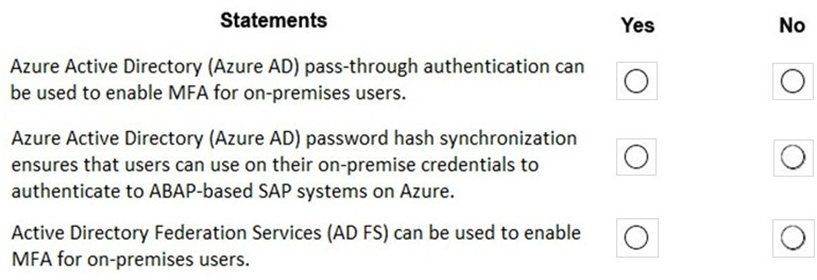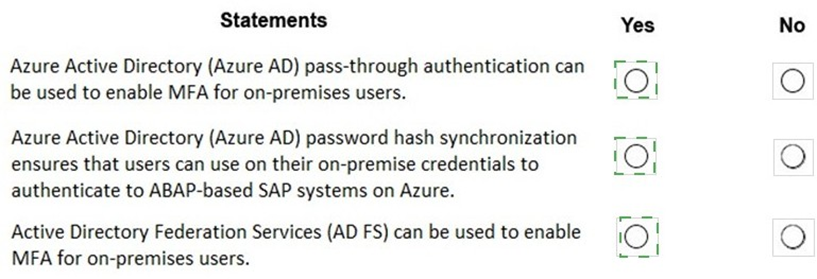
- Email support@dumps4free.com

Topic 2: Misc. Questions
Your on-premises network contains SAP and non-SAP applications. You have JAVA-based SAP systems that use SPNEGO for single-sign on (SSO) authentication. Your external portal uses multi-factor authentication (MFA) to authenticate users. You plan to extend the on-premises authentication features to Azure and to migrate the SAP applications to Azure. For each of the following statements, select Yes if the statement is true. Otherwise, select No. NOTE: Each correct selection is worth one point.

Answer:

Explanation:
Box 1: Yes
Box 2: Yes
Password hash synchronization is one of the sign-in methods used to accomplish hybrid identity. Azure AD Connect synchronizes a hash, of the hash, of a users password from an on-premises Active Directory instance to a cloud-based Azure AD instance.
Password hash synchronization is an extension to the directory synchronization feature implemented by Azure AD Connect sync. You can use this feature to sign in to Azure AD services like Office 365. You sign in to the service by using the same password you use to sign in to your on-premises Active Directory instance.
Box 3: Yes
If your organization is federated with Azure AD, you can use Azure Multi-Factor Authentication to secure AD FS resources, both on-premises and in the cloud. Azure MFA enables you to eliminate passwords and provide a more secure way to authenticate.
You plan to deploy an SAP landscape on Azure that will use SAP HANA on Azure (Large Instances). You need to ensure that outbound traffic from the application tier can flow network virtual appliances (NVAs)only to the database tier. What should you use?
A.
network virtual appliances (NVAs)
B.
network security groups (NSGs)
C.
application security groups
D.
Azure Firewall
application security groups
For each of the following statements, select Yes if the stamen is true. Otherwise, select No. NOTE: Each correct selection is worth one point.

Answer:

Explanation:
Yes, Yes, No
You plan to deploy an SAP environment on Azure that will use Azure Availability Zones. Which load balancing solution supports the deployment?
A.
Azure Basic Load Balancer
B.
Azure Standard Load Balancer
C.
Azure Application Gateway v1 SKU
Azure Standard Load Balancer
Explanation:
When you deploy Azure VMs across Availability Zones and establish failover solutions within the same Azure region, some restrictions apply:
You can't use an Azure Basic Load Balancer to create failover cluster solutions
based on Windows Server Failover Clustering or Linux Pacemaker. Instead, you need to use the Azure Standard Load Balancer SKU.
You have an SAP production landscape that uses SAP HANA databases. You configure a metric alert for the primary HANA server as shown in the following exhibit.


Answer:

Explanation:

Graphical user interface, text, application, email Description automatically generated
Box 1: No
The period is 15 minutes. Only alerts or emails will be sent. Box 2: Yes
Box 3: Yes
| Page 6 out of 44 Pages |
| Previous |